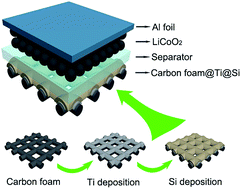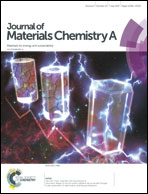Interfacial modification of a lightweight carbon foam current collector for high-energy density Si/LCO lithium-ion batteries†
Abstract
Carbonized melamine formaldehyde foam has been modified with a thin titanium layer and then used as an inexpensive and lightweight current collector. By depositing a silicon film on the thin Ti layer modified carbon foam, a self-supported Si electrode was obtained for lithium-ion batteries (LIBs). The Ti/Si interface has been further strengthened by annealing treatment, which dramatically suppressed the electrode pulverization induced by the huge volume changes of silicon in cycles. The self-supported Si electrode displayed a high rechargeable specific capacity of 1296 mA h g−1 at a current density of 2.0 A g−1 and excellent cycling performance up to 1000 cycles. When the prepared Si electrode was paired with a casted LiCoO2 (LCO) electrode to design a Si/LCO full-cell LIB, it displayed a reversible charge/discharge capability in all 200 cycles. As a result of the lightweight carbon foam collector, the self-supported electrode assembly strategy and the high specific capacity of silicon, a high-energy density of 479.5 W h kg−1 was attained. The thin titanium layer modification can be applied to improve the contact interface between other carbonaceous current collectors and active materials with inferior electronic conductivity and large volume changes in cycles.



 Please wait while we load your content...
Please wait while we load your content...